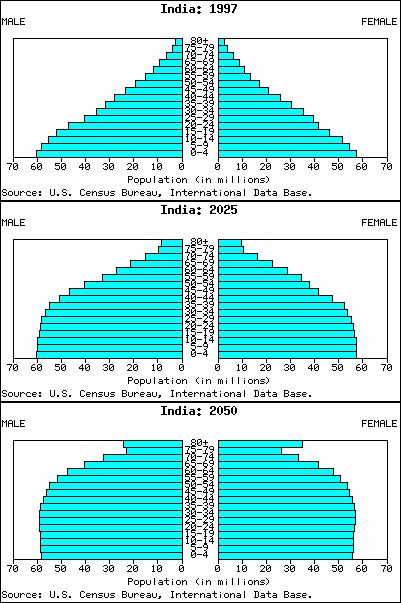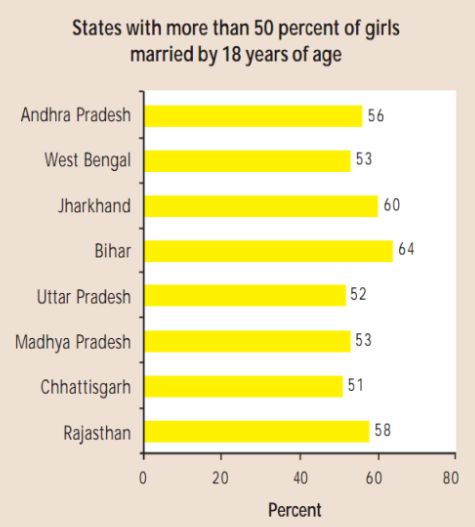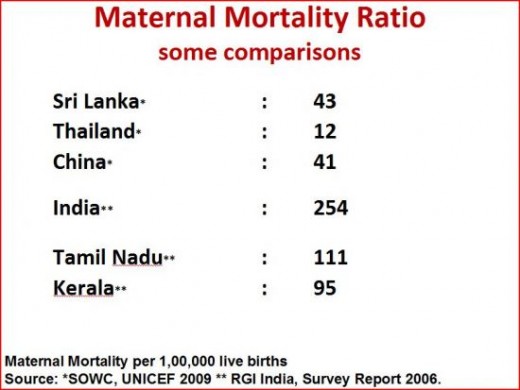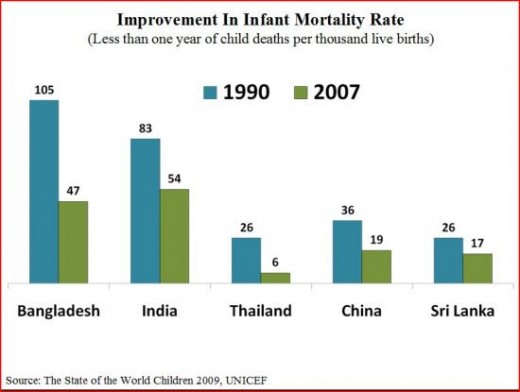Population of India: Changing Realities, Changing needs

A Brief History
Sixty years ago, India started the first national family planning program in the world. It was certainly a different world with very different realities. Indian population was just a third of what it is today and the average life expectancy was only 32 years (Today it is 67 years). The average number of children born to a woman was about six and over 20% new born infants did not survive for their first birthday. Compared with current scenario, the infant mortality rate was four times higher – 225 for 1000 live births. Interestingly, female sterilization, the most common contemporary contraceptive, did not exist then.
What was initially merely a maternal and child health program, grew into a overwhelming adventure as the Western fears of a “population explosion” was thrust upon Indian planners. Its origin can be traced back to the two hundred year old ideas of a British cleric and sociologist, Thomas Malthus. Mid seventies saw a sudden twist to the family planning initiatives when Indian policy planners, from seeing development as the best contraceptive, moved to a dictatorial and forced sterilization campaign. Over time it became an entirely target driven number game and the government machinery, from top to bottom, began to be judged by the number of “tubectomies” delivered annually.
However, some sanity was restored after the International Conference on Population and Development (ICPD) in Cairo in 1994. India began shifting gear towards a target free reproductive and child healthcare regime during 1996 – 97 and adopted a new National Population Policy in 2000, which called for an integrated approach which later transformed into the more holistic National Rural Health Mission in 2005. Along the way, spread of HIV/AIDS introduced a new dimension to the reproductive health issues, but for some reason it remained isolated from the mainstream health policy concern.
An Essay of Population, 1798
“… The power of population is indefinitely greater than the power in the earth to produce subsistence of man. Population, when unchecked, increases in geometric ratio. Subsistence increases only in an arithmetic ratio. A slight acquaintance with numbers will show the immensity of the first power in comparison of the second.”
Thomas Malthus, British social scientist and theorist
Malthus could not have imagined then, the power of scientific advances (for example, green revolution, genetic engineering) and failed to consider the immense power of natural forces to restore overall balance on the planet. Man is not yet smart enough to fully decipher all the secrets of nature’s power.
New Realities, Old Mindset
The current debate in the political and policy planners’ arena tells that they are still dogged by the Malthusian fear of a large number of hungry humans chasing a limited bucket of food supply. The two hundred year old Malthus thesis is based on a simplistic model that does not hold ground in today's world that is much more advanced and different than his time. Better informed researchers and demographers, however, talk in terms of “population dividend”, primarily due to better healthcare system available now.
The other much talked about fear is Indian population overtaking China’s and that the population stabilization will be delayed till about 2070 (from 2045 as envisaged so far). Some policy planners and bureaucrats are also concerned that the efforts to meet the Millennium Development Goals (MDGs) and NRHM objectives have taken precedence over the family planning issues. Some global experts are also trying to create a sense of urgency by trying to link population with the recent threats of Climate Change and global warming. In reality, such efforts to connect every global phenomenon with world population is like accusing Tom for Harry's crimes! We see it everywhere in the world politics.

Gaps in the Family Planning Program
Delaying marriage is an acknowledged mechanism for reducing fertility. Look at the large number of young women already married by the legal age of 18, particularly in the important and populous Hindi belt. If all marriages take place after the legal age, it will greatly reduce the momentum behind population growth.
Family planning policy is silent about the contraceptive needs of single people who delay their marriage. Likewise it also does not consider contraceptive needs of people who may not be in marriage. Further, continued emphasis on surgical methods and on long term methods such as IUDs, has left the needs of a growing younger population unattended; they primarily need temporary methods to delay pregnancy.
An over-stress on permanent methods still continues and the broader issues of needs for informed choice, a larger basket of contraceptive choices, and quality of reproductive healthcare are largely ignored. The overall design and implementation of the program has seen little change over last two decades; hence, it is quite oblivious to the changed needs of a vast majority of people.


New Realities
The rapid socio-economic and demographic changes at the local and global levels during last twenty years have substantially altered the context of reproductive healthcare and demand re-positioning of the family planning initiatives with fresh and more effective ideas.
1. Changes in Global Understanding
During the 1960s, advances in medical technologies and improvements in public healthcare increased life expectancies; thus, fueling the Malthusian fear of population putting pressure on food supply. Although the unforeseen “green revolution” mollified the fears to some extent, but the phobic mindset remained strong and the international aid became conditional to family planning initiatives. However, in the later decades increased understanding of human rights and the assertive feminist movements brought about the need for framing the family planning programs within the concept of reproductive right of individuals and couples. This was formally acknowledged in the ICPD, Cairo in 1994.
Traditionally, Indian family planning initiatives have been heavily influenced by the global trends and the fear of “population explosion” has systematically influenced the thinking of the policymakers and politicians. This fear psychosis even entered the school curriculum..
This fear of population explosion expressed itself in a series of incentives and disincentives in the family planning programs in India. For example, the “two child” initiative provides motivation for measures ranging from maternity benefit schemes to participation in the electoral politics to rationing of water for irrigation. Looking from a broader perspective, such apparently good policies don't really address the dominant root cause of population growth -- population momentum.
On the issue of contraceptive provisioning, women’s and civil society organizations have always demanded policies that are focused on women’s welfare and concerns. However, policy makers still remain obsessed with the sterilization numbers and ignore the women-care issues. Old habits die hard!!
Too Young, Too Early, Too Quick!!
Recently, the National Commission for Women reported that the prevalence of child marriage is still "alarming" in India. In some large states like Andhra Pradesh, Uttar Pradesh, Madhya Pradesh, Rajasthan and Bihar around 65 – 70 percent girls are married below the legal age of 18. Looking at the nation level, about 46% of young women marry before the legal age and 63% by 20 years.According to UNICEF, 15 percent of girls in rural areas across the country are married before 13; and 52 percent of girls have their first pregnancy between 15 and 19.
2. Changes in Demographics
In last sixty years, life expectancy has more than doubled and infant mortality rate has reduced by four times. So the increase in population is primarily due to increased longevity of people due to better healthcare and improved living conditions.
Family structure and composition has undergone major changes in last sixty years. Joint family tradition has significantly fallen apart, family size has shrunken, age at marriage has increased, and literacy level in both men and women has increased. All these changes have major bearing on reproductive decisions and contraceptive preferences.
Although average age at marriage has increased, marriage below legal age is still quite prevalent. In many states, about fifty percent girls at 18 are already married and many are already mothers. Their contraceptive needs require special attention. They are also more susceptible to sexual abuse and violence.
The population pyramid of India suggests that the dominant proportion of population is young. As per 2011 consensus, over 50% population is below 25 and and over 65% below the age of 35..
3. Changes in Fertility and Contraceptive Usage
Overall contraceptive usage has increased, from 13% in 1970s to 56% in 2005 – 06. For rural India this increase is from 37% to 53%.
Total Fertility Rate (TFR) has declined from over 6 in 1950s to 2.7 in 2005, reflecting desire for smaller families.
Over half of sterilization procedures on women are done women below 26. It is particularly common in Andhra Pradesh where the median age of sterilization is just 23.
The most frequently used spacing methods are condoms and rhythm methods (each is used by 5% of married women)
Male sterilization is the least used method. Why?? A good question for policymakers and sociologists.
4. Changes in Contraceptive Availability
In the early days of family planning in India, condoms and vasectomy were the most commonly available methods. Female sterilization, the most widely used method today, did not exist before 1980s. Laparoscopic tubectomy, the preferred method of camps, became popular sometime later.
The family planning program provides five major contraceptive methods: condom, oral pill, the Copper T, and male and female sterilization. There are some technological advances: pills have lowered oestrogen content, Copper Ts are now available in two versions, and the conventional vasectomy is replaced by non scalpel vasectomy (NSV) (Will men now come forward and opt for NSV?).
Additionally, there are some scientifically validated traditional methods such as LAM (Lactation Amenorrhoea Method) and the safe days method (cycle beads).

New Realities Demand New Thinking
1. Control Population Momentum, Not People!: To achieve this, the family planning initiatives have to move beyond the limited territory of sterilization / contraceptives and into the domain of social action. The ideal way to achieve this is through steps to prevent marriage below legal age, raising age at marriage, delaying first pregnancy, spacing child births; women education and empowerment, and so on. This requires a paradigm shift in the mindset of policy makers, bureaucrats, and politicians. They have to go beyond the world of “sterilization targets” and its implementation through incentives and disincentives. Such actions of past decades have badly distorted the family planning programs and diverted attention from the important issue of quality and comprehensiveness of family healthcare.
2. Need to think of contraceptive needs beyond marriage: The sphere of contraceptives for family planning and infection prevention is too small to accommodate the changing requirement of contraceptives for people not in marriage. In the modern urban society of India, extra marital sexual relationship is only going to increase. New policies have to address the issues of sexuality and pleasure along side sexual violence and coercion.
3. Motivate men to get involved in the family planning program: Men can play a vital role in propagation of awareness on above issues. A good suggestion is to engage male volunteers to operate along side ASHAs to work with men. Focusing attention on NSV as opposed to female tubectomy is another way to increase their involvement in the issues of family and reproductive healthcare.
4. Tubectomy is not a good option for young women below 27: Camp based targeted approach can further add to the woes of women availing the facility of such camps, because quality of care gets badly compromised under camp conditions. The much needed solution is to realize the importance of “basket of contraceptive choices” approach -- It will lead to increased availability of temporary methods accompanied by counseling services.
5. Convert the family planning efforts into a comprehensive quality based reproductive healthcare program: The goal should be to address the reproductive and contraceptive needs of individuals and couples recognizing the spectrum of changing needs across the full life. It should enable them to make truly informed choices with dignity.
6. Increase participation of women in planning and service delivery mechanisms: This will provide much needed realistic feedback into the system besides empowering them to bring in much needed gender parity. Policies should be framed based on the real (not imagined) issues of the target group; nothing can do it better in India than involving women in the process.
Acknowledgement
This article is inspired by the one day roundtable held in New Delhi (Jan 12, 2011) on “Population and family Planning: Contemporary Challenges & Opportunities”, organized by the National Coalition on Population Stabilization, Family Planning & Reproductive Rights. I gratefully acknowledge the resource material from the Center for Health and Social Justice (CHSJ), New Delhi, India.
Population in 2011
You may also like to Read
- Population Growth of India: Myths vs Realities
Indian population is seen with alarm by most people, not only in India but specially those living in the West. Is there really a population explosion? or Population bomb? Find out why such notions are mere myths. - Population of India: What the Government Should Do
The family planning initiatives in India are usually stuck only on female sterilization. Find out why this is a faulty idea and what should actually be done.








